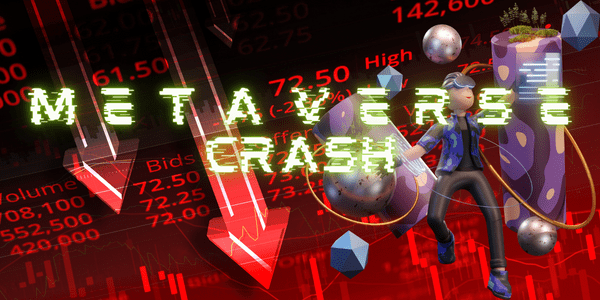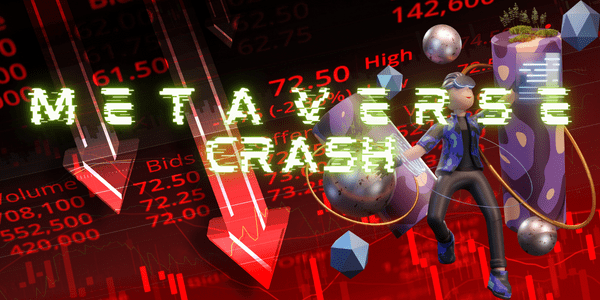
As the virtual reality sector experiences a massive decline in land prices, many are wondering what this means for the future of the metaverse.
While some believe this is simply a sign of the times, others maintain that it points to more significant underlying issues with the industry.
In this blog post, we will take a closer look at the current state of the metaverse market and explore some of the possible reasons behind these recent declines.
A Look at the Recent Market Crash
The metaverse sector is witnessing a housing crisis moment, with massive declines in the prices of its virtual lands in 2022. Led by waning users’ interest and a crypto bear market, land sales plunged 85%.
In particular, Ethereum blockchain-based metaverse projects’ valuations and other critical indicators have dropped significantly. These projects include Sandbox and Decentraland. For instance, in February 2022, the average price of land in Decentraland was above $37,00.
Disturbingly, as of August 1st, their prices had decreased to an average slightly above $5,000. Similarly, the Sandbox’s average selling price plummeted from $35,500 in January to below $3,000 in August.
From over $17,000 in January, the average price of a plot of virtual land among the six most significant Ethereum metaverse projects has decreased to roughly $2,500 in August.
The sections below will present five factors negatively influencing this new digital market.
#1 – A Market Coming from a Strong Initial Growth
The metaverse has seen a massive influx of new users and businesses in the past year. This has driven up prices and made the market more volatile.
The recent crash is hard to ignore, but it’s important to remember that the metaverse real estate market has experienced spectacular growth recently. The market is still young, and there is a lot of growth potential.
The metaverse is a new and exciting place. It offers unlimited potential for businesses and users alike. The recent market crash is a setback, but it’s not the end of the metaverse. The market will recover and continue to grow.
Few markets have grown as much as this one has. The market is still young and has a lot of potential for future growth.
The metaverse offers a unique and exciting way for people to interact with each other. Businesses in the metaverse have seen an increase in users due to the Coronavirus pandemic. This is because people seek new and innovative ways to connect with others.
#2 – The Negative Effects of Inflation on the Metaverse Real Estate Market
In the current economy, inflation is a significant concern for the metaverse real estate market. Inflation occurs when the prices of goods and services in an economy rise over time.
This can depend on several factors, including an increase in the money supply, an increase in demand, or a decrease in supply.
When inflation increases, the value of money decreases. This means that people who have saved money will find it worth less than before. It also means that it is more expensive to buy goods and services.
This can be a problem for the real estate market (both in real life and in the digital world) because it can lead to a price decline.
As inflation increases, people may be less likely to invest in real estate. They may also be less likely to buy or sell a property. This can lead to a decline in the overall value of property in the metaverse.
As a result, it may become more challenging to find affordable housing in the metaverse.
#3 – The Impact of Rising Interest Rates on Virtual Real Estate Prices
The Federal Reserve has raised interest rates several times in 2022 to tackle inflation, and analysts do not expect the board to stop its hawkish strategy.
The impact of rising interest rates on virtual real estate prices is a complicated issue. In general, as interest rates go up, virtual real estate’s value decreases.
This is because when interest rates are high, it becomes more expensive for people to borrow money, reducing the amount of money available to invest in virtual real estate.
As a result, the prices of virtual properties tend to decline when interest rates increase.
#4 – The Weight of Economic Uncertainty
One factor that has been causing uncertainty in the metaverse virtual real estate market is the economy. With the global economy in flux, people are less likely to invest in virtual land.
This has caused prices to drop and has made it more difficult for sellers to find buyers.
This trend is having a significant impact on the metaverse virtual real estate market. Sellers are lowering their prices to attract buyers, causing a decline in the overall value of virtual land.
#5 – An Extremely Young Market Dealing with Volatility
An extremely young market like this one often comes with volatility. Inexperienced investors can be swayed by the constant price fluctuations and may buy or sell at the wrong time.
It is therefore vital to do your research before making any decisions about investing in the metaverse. The market is still in its infancy, and there is no telling how it will develop over time.
Prices could potentially skyrocket or plummet, depending on some factors. It is important to remember that investing in the metaverse is risky, and you should only invest what you can afford to lose.
A substantial decline after a rapid growth phase is not an unexpected event. However, young and inexperienced investors may fall into panic, worsening the market crash.
Final Thoughts
The metaverse virtual real estate market is going through a rough patch, with prices dropping and sellers struggling to find buyers. While there are several reasons for this decline, it is essential to remember that the market could rebound in the future.
So far, rising interest rates and economic uncertainty have been the most significant factor in causing volatility in the market. It is essential to do your research before investing in virtual property in the metaverse.
 Sections of this topic
Sections of this topic
















